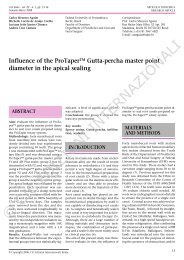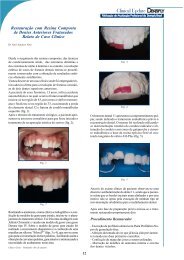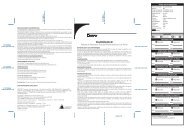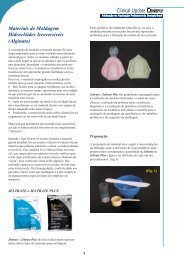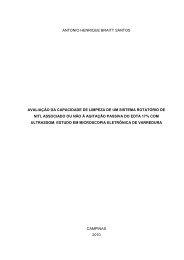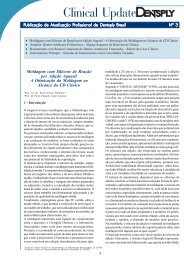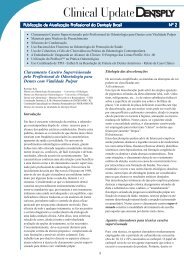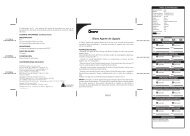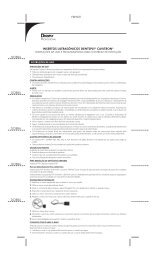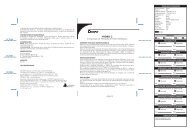Create successful ePaper yourself
Turn your PDF publications into a flip-book with our unique Google optimized e-Paper software.
Manhart/Trumm<br />
heim, Germany), resulting in four readings for each specimen<br />
at the enamel and dentin adhesive interface. An ordinal<br />
scale from 0 to 4 was used to score microleakage separately<br />
at the enamel and dentin margins of each section<br />
(Fig 2). 6 Each section was examined under a stereomicroscope<br />
(Stemi SV 11, Zeiss; Oberkochen Germany) at 40X<br />
magnification and scored by two examiners. Consensus was<br />
forced if disagreements occurred. 16 The results of the microleakage<br />
investigation were analyzed using the nonparametric<br />
Kruskal-Wallis H-test and post-hoc Mann-Whitney<br />
U-test at a significance level of p < 0.05.<br />
RESULTS<br />
Microleakage results are presented in Table 2. The Kruskal-<br />
Wallis H-test revealed statistically significant differences<br />
among the experimental groups in the enamel (p = 0.001)<br />
and dentin margins (p = 0.022) of the Class II restorations.<br />
DISCUSSION<br />
Microleakage studies provide adequate screening methods,<br />
possibly determining what kind of adhesive system will show<br />
acceptable clinical performance. 13 While quantitative marginal<br />
analysis by scanning electron microscopy assesses the<br />
entire circumference of the tooth/restoration interface, it can<br />
only determine the quality of the adhesive interface at the<br />
cavosurface margin. The extension of marginal gaps towards<br />
the axial wall of restorations is commonly assessed by microleakage<br />
studies. 10 Detection of microleakage can be accomplished<br />
with a number of techniques, including bacteria,<br />
chemical or radioactive tracer molecules, fluid permeability,<br />
and dye penetration. 1 The most common technique is the<br />
use of dyes, the penetration of which is determined after sectioning<br />
of the specimen with a magnifying aid.<br />
The type of solvent strongly influences the clinical application<br />
protocol of etch-and-rinse adhesive systems. Acetonebased<br />
systems only work well on a moist dentin surface as<br />
acetone is a water chaser and can lead to rather poor results<br />
on overdried acid-etched dentin surfaces. On the other<br />
Fig 1 Incremental restoration technique and light curing direction.<br />
11<br />
hand, water-based systems are not as sensitive with regard<br />
to dentin moisture content, as they have inherent rewetting<br />
properties, but require a longer evaporation time for the solvent,<br />
because water has a considerably lower vapor pressure<br />
than acetone. 18 If the solvent is not completely evaporated<br />
before light curing the adhesive, flaws can weaken the<br />
hybrid layer, probably causing premature restoration failure. 2<br />
A new type of solvent for adhesives, namely, tert-butanol, was<br />
introduced for XP Bond. Tert-butanol (2-methyl-2-propanol)<br />
Table 2 Microleakage frequency scores at enamel and dentin margins in the experimental groups G1 to G5.<br />
Enamel<br />
Dentin<br />
Leakage 0 1 2 3 4 Mean rank Leakage 0 1 2 3 4 Mean rank<br />
score (Kruskal- score (Kruskal-<br />
Wallis)<br />
Wallis)<br />
G1 28 0 4 0 0 66.69 a G1 20 3 4 5 0 74.4 A<br />
G2 28 3 1 0 0 64.44 a G2 18 1 7 4 2 81.84 A,B<br />
G3 15 7 9 1 0 98.25 b G3 23 5 1 2 1 65.53 A<br />
G4 24 4 4 0 0 74.88 a G4 19 2 2 7 2 81.09 A,B<br />
G5 15 7 9 1 0 98.25 b G5 10 6 7 6 3 99.61 B<br />
Different superscript letters indicate statistically significantly different subsets within each margin segment as determined by post-hoc<br />
multiple comparisons with the Mann-Whitney U-test (p < 0.05)<br />
Vol 9, Supplement 2, 2007 263



